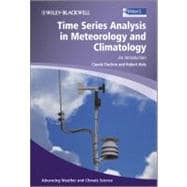
Note: Supplemental materials are not guaranteed with Rental or Used book purchases.
Purchase Benefits
What is included with this book?
Claude Edward Duchon, Professor Emeritus, School of Meteorology, University of Oklahoma
Robert C. Hale, Research Scientist, Cooperative Institute for Research in the Atmosphere, Colorado State University
| Series foreword | p. vii |
| Preface | p. ix |
| Fourier analysis | p. 1 |
| Overview and terminology | p. 2 |
| Analysis and synthesis | p. 6 |
| Example data sets | p. 14 |
| Statistical properties of the periodogram | p. 23 |
| Further important topics in Fourier analysis | p. 47 |
| Subroutine foranx | p. 83 |
| Sum of complex exponentials | p. 86 |
| Distribution of harmonic variances | p. 86 |
| Derivation of Equation 1.42 | p. 92 |
| Problems | p. 93 |
| References | p. 99 |
| Linear systems | p. 101 |
| Input-output relationships | p. 102 |
| Evaluation of the convolution integral | p. 104 |
| Fourier transforms for analog data | p. 110 |
| The delta function | p. 113 |
| Special input functions | p. 118 |
| The frequency response function | p. 122 |
| Fourier transform of the convolution integral | p. 128 |
| Linear systems in series | p. 130 |
| Ideal interpolation formula | p. 132 |
| Problems | p. 137 |
| References | p. 142 |
| Filtering data | p. 143 |
| Recursive and nonrecursive filtering | p. 144 |
| Commonly used digital nonrecursive filters | p. 150 |
| Filter design | p. 159 |
| Lanczos filtering | p. 161 |
| Convolution of two running mean filters | p. 173 |
| Derivation of Equation 3.20 | p. 176 |
| Subroutine sigma | p. 177 |
| Problems | p. 180 |
| References | p. 182 |
| Autocorrelation | p. 183 |
| Definition and properties | p. 184 |
| Formulas for the acvf and acf | p. 188 |
| The acvf and acf for stationary digital processes | p. 192 |
| The acvf and acf for selected processes | p. 195 |
| Statistical formulas | p. 201 |
| Confidence limits for the population mean | p. 206 |
| Variance of the acvf and acf estimators | p. 211 |
| Generating a normal random variable | p. 215 |
| Problems | p. 216 |
| References | p. 221 |
| Lagged-product spectrum analysis | p. 223 |
| The variance density spectrum | p. 223 |
| Relationship between the variance density spectrum and the acvf | p. 226 |
| Spectra of random processes | p. 230 |
| Spectra of selected processes | p. 232 |
| Smoothing the spectrum | p. 236 |
| Proof of Equation 5.11 | p. 239 |
| Proof of Equation 5.12 | p. 240 |
| Problems | p. 241 |
| References | p. 243 |
| Index | p. 245 |
| Table of Contents provided by Ingram. All Rights Reserved. |
The New copy of this book will include any supplemental materials advertised. Please check the title of the book to determine if it should include any access cards, study guides, lab manuals, CDs, etc.
The Used, Rental and eBook copies of this book are not guaranteed to include any supplemental materials. Typically, only the book itself is included. This is true even if the title states it includes any access cards, study guides, lab manuals, CDs, etc.